HALF PRICE SALE ENDS AT MIDNIGHT ON FRIDAY – ORDER NOW!
***TODAY ONLY – GET AN EXTRA 10% OFF SALE PRICES WITH CODE FLASH10***
Menu
HALF PRICE SALE ENDS AT MIDNIGHT ON FRIDAY – ORDER NOW!
***TODAY ONLY – GET AN EXTRA 10% OFF SALE PRICES WITH CODE FLASH10***
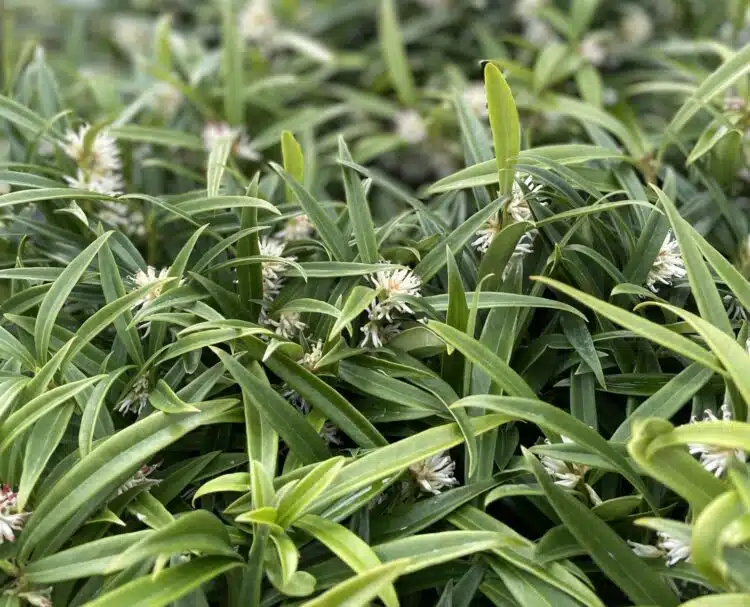 https://www.hopesgrovenurseries.co.uk/wp-content/uploads/2024/02/IMG_5389-750x607.jpeg
https://www.hopesgrovenurseries.co.uk/wp-content/uploads/2024/02/IMG_5389-750x607.jpeg
Gardening is so much more than hard work and dirty fingers: it’s a sensuous and hedonistic experience too. Sometimes the pleasure’s completely visual and, at this time of year, it might be a red peony shoot thrusting through the soil or a lumbering queen bumblebee dusted in pollen. You could be admiring an unexpected arrival, the seedling that’s placed itself much more perfectly than you could have ever managed. Or you might be welcoming the return of an old friend, one of those plants you’ve had for many a year.
On the scale of 1 to 10 though, the most hedonistic thing of all is fragrance because it triggers all sorts of pleasant memories within nanoseconds. Thankfully, many an early-flowering plant packs a pungent scent designed to lure in early flying pollinators. The flowers aren’t colourful or showy. They tend to be subtle and small in form, but that adds yet more charm. I find myself wondering how does such an insignificant flower produces such a strong fragrance? It’s a miracle. However, if a plant’s smells divine it needs a quiet spot where it’s warm and bright so that the nectar flows and the fragrance travels. Aim for places near a path or gateway. And then that plant will please you again and again.
You don’t have to have a large garden to capture winter fragrance, because the most powerfully scented plant of all is a compact, Asian evergreen named Sarcococca or Christmas box. The flowers consist of clusters of downward-facing pink or white stamens, usually held in pink calices. The leathery evergreen leaves frame the multitude of flowers wonderfully well and these plants look their best in winter and early spring. They should get a gold medal for versatility too for they can be grown in a rugged container, although they will need feeding with a high nitrogen fertiliser during the growing season if the foliage is to keep its lustrous quality. Readily-available chicken manure, powdered or pelleted, is ideal. Sarcoccocas can also form low hedges, or they can make specimen shrubs in the garden. And even a small one packs a significant punch. In colder places, sarcococcas usually reach a I00cm (39in) in the ground, but they can get to 150cm (60in) and more in warm, moist areas of Britain. Black berries follow by summer.
Sarcococcas, like most Asian plants, grow lusher and more luxuriant when summer rainfall is generous. Despite that, mine weathered the dry summer of 2022 with ease. Once established, it’s obvious that they can cope with very dry conditions. Let’s give them another gold medal for being easy to grow! They will even grow on chalk.
Sarcococca confusa, my personal favourite, has ivory-white flowers framed by rich-green foliage. It’s the elegant Audrey Hepburn model, a sophisticated mixture of ivory-white and green. The heady scent has a touch of lily and the foliage stays a vivid-green throughout the year. The name ‘confusa’ arose because the plant hunter who found it in Western China noted it and then failed to find it again – leaving him thoroughly confused!
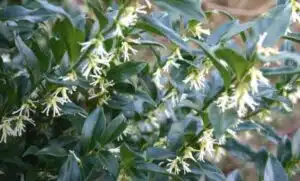
There are more scented options and the one that packs the most powerful lily-like scent is Sarcococca hookeriana var. digyna. The flowers consist of clusters of downward-facing white stamens, held in pink buds, and the lance-like foliage tends towards olive-green. It’s a more colourful affair than ‘confusa’, but perhaps a touch less elegant. More Doris Day than Audrey perhaps?
‘Humilis’ is a smaller plant with a more suckering habit, so it’s ideally suited to a border edge or a hedge. It’s replacing box in many gardens, where box blight and box caterpillar have ravaged the hedge. It should not be clipped to form a hard contoured edge though, as you would with box, otherwise you will lose those fragrant flowers. ‘Purple Stem’ does what it says on the tin, producing colourful purple stems and flowers that appear pink. The stems shine because the well-spaced foliage is longer and narrower, rather willow-like.
A recent UK hybrid raised by Peter Moore, ‘Winter Gem’, is a hybrid between S. hookeriana var. digyna ‘Purple Stem’ x S. hookeriana var. humilis. It has inherited the best traits of both parents, having larger than average, rich-green leaves and honey-scented white flowers held in pink calices. It’s the earliest to flower, as the name implies, and red berries follow and then they ripen to the usual black. Although tough and tolerant of most conditions, I fancy that ‘Winter Gem’ is not as quite as hardy as the others, so find it a sheltered spot. It’s very good in a container, or in shade.
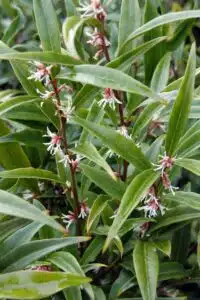
If you’ve space, wintersweet or Chimonanthus praecox, will make a large shrub and the pallid flowers, which appear on bare branches, are full of sweet, fruity fragrance with a citrus-flavoured twist. It’s often said to need a warm wall, yet it thrives in an open spot in my cold garden and it’s always full of flower early in the year. The translucent, pale-yellow flowers have a warm touch of wine-red in the middle and you can smell this one, even on a cool day. It also cuts really well, outlasting other winter flowers. The downside of this large shrub, which can reach 4m (12ft), is the scruffy summer foliage but I think it’s worth it. Frost seems less of a problem to the flowers than heavy rain.

Not all honeysuckles twine and climb, some are shrubby and they include Lonicera fragrantissima. This produces sweetly scented cream flowers from January onwards, just before the leaves appear. Early flying honeybees love it and it’s also good for cutting. It’s lovely planted by a gateway, but it also needs space because this shoulder-high shrub can span some 8 feet across. (2.4m)
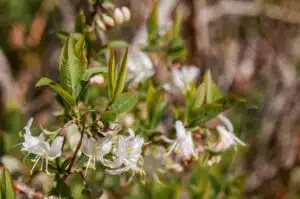
Viburnum x bodnantense bears a succession of fragrant pink flowers on bare branches. The hyacinth scent is strongest in November, when the first flowers begin to lighten the gloom. Afterwards, this accommodating shrub produces flushes of flower, whenever the weather allows, ending in a final flourish in spring. It’s tall and upright, so it can form an informal hedge or it can be placed on a boundary, because the strong fragrance carries.
Osmanthus x burkwoodi , a slow-growing white-flowered evergreen with an excellent jasmine scent, has dark-green foliage that’s rather privet-like in form. This could be tedious, but the serrated foliage is enlivened with a golden edge, so fine it could be a silken thread. This picks up the paler midrib and when the buds lie in waiting it’s the same sort of golden patina repeated again. White scented flowers follow, shining out against cinnamon-coloured stems and they all point in one direction. It’s the Coco Chanel in plant form, stylish and somewhat understated. It will tolerate shade.
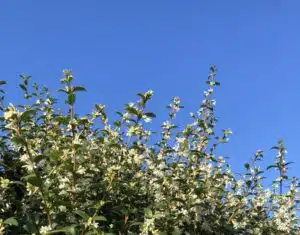
Daphnes are mostly scented and evergreen and, just like most evergreens, they are not as hardy as deciduous plants. Some slow-growing, evergreen daphnes can be capricious in nature. They can fade without good reason, after a number of years but that shouldn’t put you off because a garden without a daphne is like a martini without ice.
The easiest of all is the spring-flowering Daphne odora ‘Aureomarginata’. This wider-than-tall evergreen has clusters of waxy, cool-pink flowers set among green foliage that’s finely-edged in pale-yellow. The heady scent is particularly strong on warm afternoons.
‘Aureomarginata’ is preceded by the January-flowering D. bholua and there’s a hybrid between them named ‘Perfume Princess’. The pink flowers, clustered together above the foliage, are larger and perhaps nit a numerous but, once established, it’s still very floriferous.
Daphnes, fairly close relatives of thyme, enjoy good drainage. They develop a deep, root system after a season or two. However, they must be watered in their first growing season. Daphne x transatlantica ‘Eternal Fragrance’ is a rounded evergreen that can produce flowers between January and summer – hence the name.
Sometimes plant names defy logic and Corylopsis pauciflora (literally poor-flowering hazel-like plant) is one such name. If it loves you and you have acid to neutral soil, every branch will be smothered in primrose-yellow danglers. The sweet scent will soothe away your cares in early spring. If you can’t picture this, the clusters of flowers are similar in form to flowering currant – Ribes sanguinea. The pallid-yellow corylopsis colour offers a touch of the moonlight serenade.
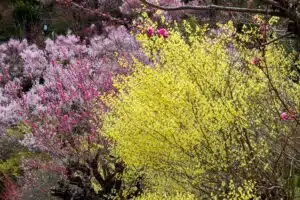
Many of our customers buy topiary plants (and hedging plants) to grow in containers, one frequently asked question is how large does the pot that I plant them into need to be?
Expert horticultural advice on the merits and pitfalls of planting bare root yews, and how to get the best from them.
Pleached trees are a garden-design favourite, because they provide an instant leafy screen that looks stylish as soon as it’s planted. They offer privacy for you and they help to muffle noise and that’s becoming more important in our busy world. They provide a living screen that’s far more eco-friendly than a stark wooden fence…